Menu

Did you know that, in 2014, the US exported $12.6 billion in agricultural goods? The European Union was the 5th biggest market for these goods. From 2000 to 2014, the US’s agricultural exports worldwide grew by 193%. However, exports to the EU only increased by 94% in the same time. This shows there’s a big chance for more growth in US agricultural exports.
The US is a key player in global farming. Its abundant land helps it produce a lot. This production includes goods that the world wants to buy. We can sell more by using new ideas, making good trade deals, and staying up-to-date with what’s popular in different markets. These steps will help the US keep its title as a big exporter of farm products.
This piece is here to help farmers, sellers, and decision-makers look at how they sell more globally. We’ll share smart tips and ways to get ahead in international markets. By using these, more opportunities to sell abroad can be spotted. This means more money coming in and spreading growth in the US economy.
The of the US boost . In 2012, exports brought in a huge $141.3 billion, 10% of all US exports. This shows how vital is to the economy.
Nearly one million jobs in the US hinge on , keeping people employed. For every $1 billion in exports, 6,800 Americans find work. The US not only sells more than it buys, but it also proves its farming power, boosting .
Most exports were high-value goods, earning $89 billion, more than half. Bulk products made up the rest, bringing in $52 billion. Grains and feeds were the biggest contributors at nearly $32 billion, closely followed by soybeans at $25 billion.
Economic growth through agriculture is also helped by increased global demand for US goods. Beef, poultry, and pork have seen big increases in the last 20 years. The 2012 farm income hit $112.8 billion, a 125% jump from earlier, showing the sector’s improvements.
The future looks good for in the US. By diversifying exports and tapping into global markets, the US is a key player. It promotes stable worldwide.
Farmers in the United States find a wealth of trading chances in the global agri export market. Between 2013 and 2023, US agricultural exports grew steadily by 2.1% each year. This growth shows the ongoing potential for American agricultural products. In 2023, these exports were worth $178.7 billion, although this was $17 billion less than the year before, revealing the market’s unpredictable nature.
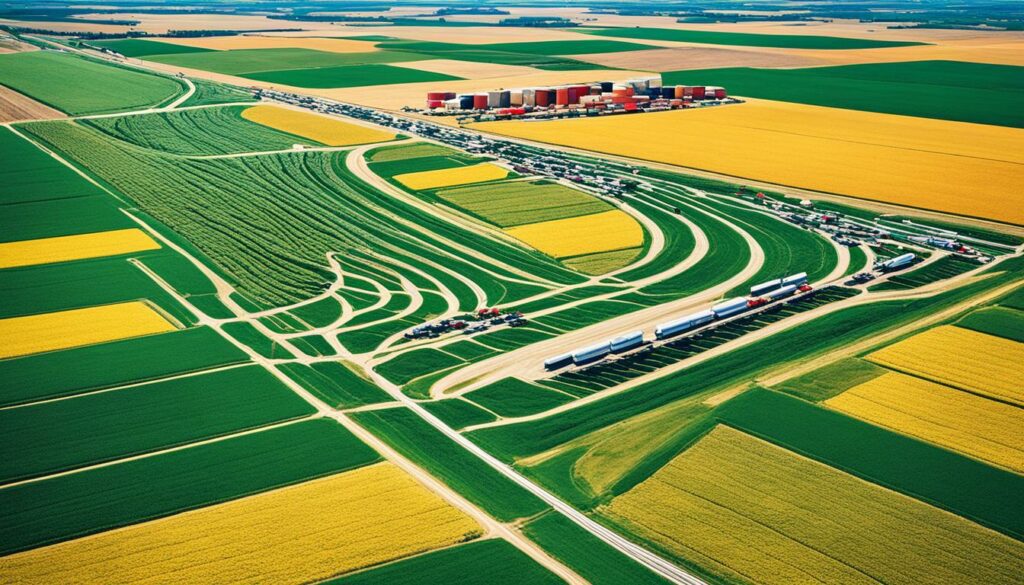
The European Union was once the top spot for US agri goods but now has its challenges. High tariffs and complex rules can make trading tough here. Yet, there’s a high demand for top-notch grains, feeds, oilseeds, and meats. This demand creates great chances for farmers who can handle the market’s difficulties.
The Asia-Pacific area is booming, with a growing middle class that loves quality foods. China is the biggest buyer of US agricultural goods, spending $33.7 billion. From 2017 to 2021, East Asia and North America bought 60% of what the US exported. This growth trend in Asia means even more trading opportunities for farmers.
In 2023, Canada and Mexico were key buyers of US agricultural goods. They’re not only close by but also major suppliers to the US. Canada sold an average of $30.9 billion and Mexico $25.5 billion from 2017 to 2021. This shows the strong and ongoing trade connections in the region.
Emerging markets are fresh and full of potential. Areas like Africa are gaining trading importance fast, thanks to growing populations and economies. The USDA ERS highlights places like Brazil and India as big opportunities for US exports. These markets bring new chances for farmers who can meet their needs.
| Region | Top Markets | Export Value (2023) |
|---|---|---|
| North America | Canada, Mexico | $59.2 billion |
| Asia-Pacific | China, Japan | $45.7 billion |
| European Union | Germany, Netherlands | $25.5 billion |
| Emerging Markets | Brazil, India | $10.8 billion |
In summary, the agri export market is a vast place for US farmers to explore. Each market, including North America, the European Union, and the Asia-Pacific region, has its own unique chances. The US is in a good spot to make the most of these international opportunities.
Navigating the world of agricultural export challenges means dealing with tariffs and non-tariff barriers (NTBs). These obstacles can reduce the chance for U.S. agricultural products to succeed in international markets. Efforts are underway to lower these barriers. This aims to help American farmers trade more globally.
Tariffs are like taxes on imports. They can affect trade a lot. The average global tariff on farm products is about 10%, but this varies greatly worldwide. For example, South Korea charges a high 79% tariff on agricultural goods. However, they only tax non-farm products at 4%. Most countries tax farm goods more, making it hard for U.S. exports. If these tariffs were removed, global trade would go up by 11%. This improvement could bring almost $56.3 billion in benefits to consumers.
| Region | Current Tariff | Predicted Increase in Trade |
|---|---|---|
| Global Average | 10% | 11% |
| South Korea (Agricultural Products) | 79% | Significant |
| South Korea (Corn) | 328% | Significantly High |
Non-tariff barriers (NTBs) include strict rules and limits. They can reduce market chances and give EU products an edge. The U.S. and EU work together through the Transatlantic Trade and Investment Partnership (T-TIP). They aim to make different rules more alike. This would cut compliance costs while keeping high health, safety, and environmental standards.
Working on technical barriers to trade (TBT) in T-TIP would make standards clearer and more open. This might let U.S. bodies check and okay products for Europe. It also seeks to make it easier to agree on international standards. Dealing with health and agricultural rules (SPS) could help get top U.S. food products, like beef, pork, and poultry, to Europe safely.
Barrier reduction strategies help make rules clearer and boost the economy. The U.S. and EU want to cut rule differences without losing safety. Finding this balance is key for getting more U.S. farm goods sold overseas fairly.
The US is a leader in selling high-value agricultural products worldwide. Its main exports are meats and dairy, fruits and vegetables, and processed foods and beverages. These items bring a lot of money and opportunity for growth to the US.
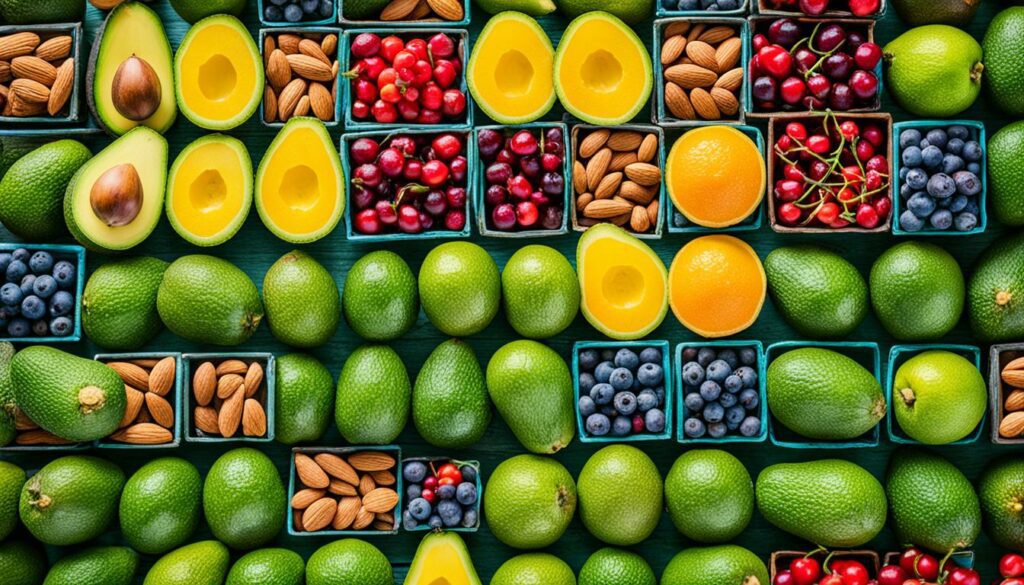
Meats and dairy play a big part in what the US sells to other countries. They are known for their top quality, giving the US an edge. Thanks to trade deals, we can expand even further. US meats are respected worldwide. Dairy products like cheese and milk are in high demand. Their variety and safety standards make them popular abroad.
Vegetables and fruits are key among the US’s exports. Places like California and Florida send lots of fresh produce worldwide. This variety meets the needs of health-conscious and those looking for organic food. From apples to tomatoes, there’s something for everyone, showing our broad export range.
Processed foods and drinks are also big exports for the US. This includes snacks, meals, soft drinks, and alcohol. The US’s modern ways of preparing and packing food make it appealing. This variety helps us reach many markets and meet global consumer tastes.
In conclusion, US agriculture is doing very well in global markets. By keeping up the good work in production and exports, our farming economy stays strong. This also helps maintain good trade relations with other countries.
Trade deals like the Trans-Pacific Partnership (TPP) and Trans-Atlantic Trade and Investment Partnership (T-TIP) offer big chances for the US in farming exports. They want to lessen both tariff and non-tariff barriers, make challenges fairer for US makers, and improve how rules and co-operation are shared.
The TPP links countries like Australia, Japan, Mexico, New Zealand, and Vietnam. These countries make up a big part of the global farming market. This deal is key for building stronger trade ties and helping the US to compete well. It lessens tariffs and simplifies rules, making trading easier and cheaper. This opens new opportunities for agriculture in the world trading scene.
The T-TIP aims to make economic connections between the US and the European Union stronger. It works on making it easier to enter each other’s markets by reducing lots of the barriers that stop farming products from being traded. This deal wants to make trading between the US and the EU better and to set new standards for world trade. This helps American farming goods by making rules more similar and lowering the work to follow them.
Using these trade agreements improves the US’s farming export growth and keeps it competitive worldwide. By using the benefits and market access from TPP and T-TIP, the US becomes an important player in world trade.
The future looks bright for American farmers through sustainable agriculture and export chances. With new farming methods and environmentally friendly practices, the US can boost its exports. At the same time, it helps the planet.

Using climate-smart agricultural practices is key to making farming more sustainable. These methods help us cope with climate change and cut down on harmful gases. The USDA says practices like rotating where animals graze, planting cover crops, and using water well can increase what farmers produce.Partnerships between the government and companies boost the value of US farm exports by $9.6 billion each year. This shows the benefit of using such methods for farmers.
New technologies are changing the farming game. Innovative farming technologies include things like precision farming, modifying genes in plants, and using big data. These methods can help farmers grow more food and use their resources better.The USDA is investing $2.3 billion to help farmers use these technologies. This could mean a big jump in how much American farmers can sell. Besides, with the world wanting more eco-friendly and ethical products, these tools are even more valuable.
Some international markets are perfect for eco-friendly farming. For example, Brazil has gotten rid of extra charges on many US farm items. Also, Canada is setting new nutrition label rules, which gives US farmers a chance to meet global quality standards. This can make US goods more attractive overseas.
| Region | Import Regulations | Market Potential |
|---|---|---|
| Southern U.S. | One-third of farm cash receipts from agricultural exports | High |
| Brazil | Eliminated import tariffs on multiple products | High |
| Canada | Nutrition labelling compliance by 2026 | Moderate |
In summary, sustainability and new farming tech are vital for US farm exports. These practices are good for our planet. They also help find new markets, making sure the US is a top farm producer worldwide.
Creating a strong food system is key for the US’s agriculture export business. It helps protect against threats and keeps the export flow going. This ensures the economy stays stable.
The Regional Food Systems Initiative (RFSI) program is working on this issue. It focuses on helping small farms and food businesses. These projects aim to make processing, gathering, and distribution of local foods better.
In Illinois, the Agriculture Department is giving grants for improving how food gets from farm to table. These grants help all kinds of groups, from farmers and businesses to schools and hospitals. They make sure everyone can benefit, especially those who usually get left out.
The RFSI offers grants for different needs. For example, groups can apply for grants to improve their facilities. And there are grants only for buying equipment.
Looking to the future, it’s important for the US to keep up with new technology. This will make its agriculture exports stronger. Big companies using blockchain, like Walmart and IBM, show the path to a more modern and secure food supply.
It’s key to back our local farmers and make our agriculture stronger. Innovation is supporting our local and regional food systems, with over $32 million helping 98 projects grow. This support is mainly from the Farmers Market Promotion Program (FMPP) and the Local Food Promotion Program (LFPP).
This year, 55 projects got a boost from the FMPP to improve markets from the producer to the consumer. This includes farmers markets, roadside stands, and online shops. The LFPP contributed to 33 projects helping local and regional food businesses thrive. These efforts are creating jobs and growing the economy in farming areas.
The Regional Food System Partnerships (RFSP) are linking local food businesses with schools and hospitals. This year, 10 partnerships were made to better connect communities and make healthier food accessible. In New York, the Farm-to-School initiatives are helping students eat better and supporting local farmers.
Programmes like the NYS 30% Initiative and Farm-to-School are showing great results. Schools buying 30% of their food from local farms are getting more money to make lunches better, from 5.9 to 25 cents per meal.
The Local Agriculture Market Program (LAMP) is also playing a big role. Started by the 2018 Farm Bill and now with more funding in 2023, it supports our farmers with money, research, and help. This boosts our markets and gives small and mid-sized farms better chances.
With a team effort, we’re making strong and clever food systems. Thanks to the American Rescue Plan, $400 million is being used to help our local food businesses for the next five years. This is about making sure our food supply is safe and steady.
By supporting varied agriculture and local projects, the US is creating a food system that can face any challenge. This way, we help our local farms and grow a market that’s strong and secure. This also keeps our food supply reliable and gets the economy moving.
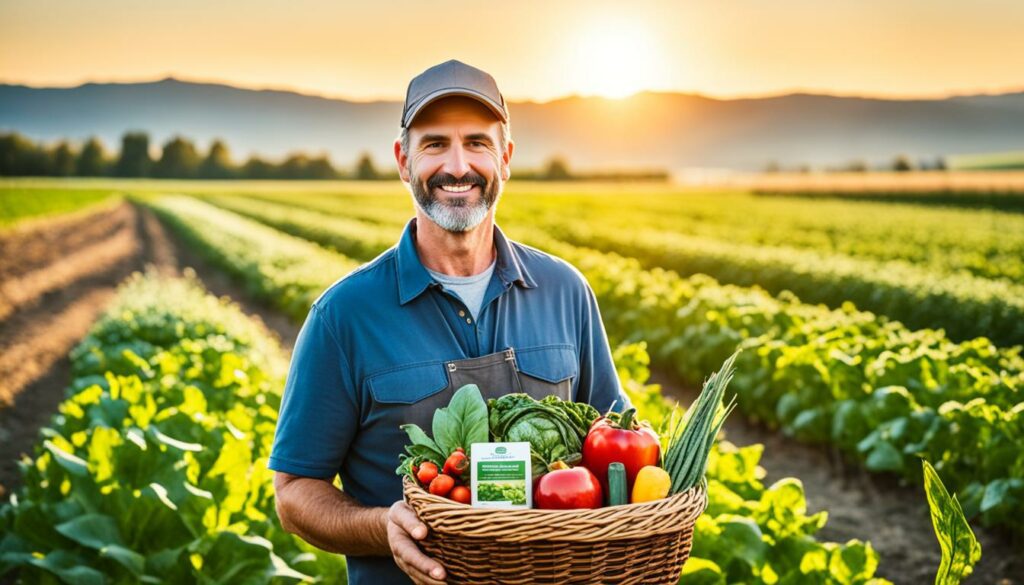
Biobased products are changing the way we think about farming and export goods. They include liquid fuels, chemicals, and building materials. These make use of plants and show the US is serious about sustainable trade.
The US has lots of land for farming and forests. It has about 280 million tons of leftover plant material every year. This material can now be used to make things like chemicals and fuels. This helps the US use less oil from other countries. Also, there’s about 35 million acres of land not used for farming that could be. This could allow for more plant-based goods to be made, helping both the environment and trade.
Efforts are being made to grow biobased products in farming. For example, crops like rapeseed for oils, corn for chemicals, and plants for polyesters. By making these new crops, agriculture can create more things to sell around the world. Combining making food for people and animals along with these products helps avoid problems. This way, creating plant-based items won’t get in the way of feeding people.
Using plant material to make items is a good idea, but it’s not done much yet. Making these items is still too expensive. The goal is to make it cheaper, by 2010. Also, laws are being made to help companies switch to making more things from plants. This would help sell more abroad and keep the US strong in the world trade.
Making fuels and products from plants helps the US use less oil from other countries. Initiatives like the BioPreferred Program show the US is serious about this. Currently, using plants for energy and goods makes up 3% of US energy. This helps the countryside where farms and forests are. By using more plants in this way, it supports these local economies.
The President wants to use more plant materials for products and energy. This is good for selling more abroad and for US companies to do better. By focusing on new science and policies, the US aims to be a leader in selling these plant-based products. This helps keep US farming strong and important worldwide.
| Statistic | Details |
|---|---|
| Waste Biomass Generation | 280 million tons annually |
| Marginal Cropland Potential | 35 million acres |
| Current Biomass Utilisation | 3% of U.S. energy production |
| Corn Starch and Ethanol | 7% of U.S. corn grain production |
The growth of the middle-class globally is a big chance for the US to sell more farm products. More people in places like the Asia-Pacific region now have more money to spend. They are choosing to buy better and more varied farm goods from the US. This change has opened up new markets and increased the need for what we grow.
American farm exports have jumped, from making $51 billion in 2000 to $78 billion by 2007. The middle-class worldwide is buying more high-quality food. This includes items like meat, dairy, and processed foods. In 2006, 43% of US exports went to new, important markets.
Asia, with leaders like China and India, is eating up these farm products. They are growing economically by 7.8% (China) and 7.5% (India) every year. In 2007, Mexico and China alone created a quarter of these exports. This shows a big chance to sell even more there.
The US is getting better at selling to fast-growing economies since the 1990s. The sector’s pie of global GDP has gone from 43% in 1996 to 50% by 2006. This bigger share means more sales for the US.
With more money and new tastes in food, many countries are looking to buy more from the US. This change is good for our farm export business. It matches our growing ability to meet the world’s growing want for top-quality farm goods.
Middle supply chains are key in moving food efficiently and making our food system strong. The USDA is boosting these chains to meet higher demands during the COVID-19 outbreak. It’s an essential move to keep everyone fed.
The USDA is also investing in local and regional food schemes. They’re putting nearly $1 billion into projects that use smart farming to make food and jobs. This will help the U.S. keep its farming edge while being friendly to our planet.
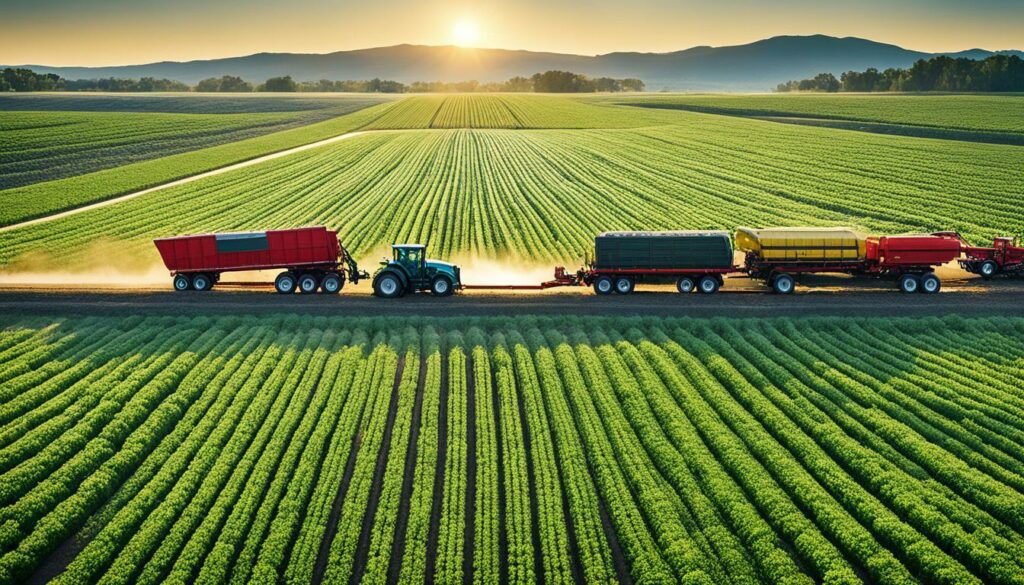
The USDA’s introduced the RFSI Program to help make food systems more resilient. They’ve got grants for things like new equipment and big infrastructure. By teaming up with groups like the FFGF, they aim to keep a steady flow of local food across New York and beyond.
The RFSI Program asks for plans that help food move better. This might mean building or buying things, making what you’ve got better, or making sure food is safe. But, you can’t use the money for buying land or for certain types of food processing.
They’ve also made it easier for some groups to get help through cost-sharing. This means they don’t have to put in as much money. The USDA really wants to give this chance to more people, making the program fairer for all.
Investment and incentives for farmers are vital for a strong agricultural sector and boosting agri exports. The USDA has been a big help, giving $3.1 billion to over 30,000 farmers and ranchers in 2023. This investment is key for keeping domestic production stable and supporting worldwide competition.
In 2023, the Risk Management Agency (RMA) provided a record $207 billion to protect American agriculture. The USDA also gave over $1.8 billion through the ReConnect Program to 96 projects. This supported 11,000 farms and 7,300 rural businesses, helping them in global markets.
The USDA also focuses on conservation, adding nearly 5,300 more producers across the country to conservation programs. It allocated $19.5 billion to these programs. These steps help in innovation and sustainable farming, keeping the US a top export player.
In 2023, the USDA funded $1.77 billion for 667,000 agricultural producers for conservation. The REAP received a $362 million investment in renewable energy. These priorities enhance the long-term sustainability and competition of US agri exports.
The Forest Service worked on 4.3 million acres to lessen wildfire risks, investing $197 million. This shows preparing against climate risks is crucial. It helps in keeping the supply chain steady for agri exports.
Moreover, the USDA invested $30 million in enhancing school meals in 264 small and rural areas. These steps, with market and capital access, help farmers join global agricultural trade efficiently. They make sure US agricultural exports stand strong internationally.
| Programme | Investment | Beneficiaries |
|---|---|---|
| Inflation Reduction Act | $3.1 billion | 30,000+ farmers and ranchers |
| Risk Management Agency | $207 billion | American agriculture |
| ReConnect Program | $1.8 billion | 11,000+ farms, 7,300 rural businesses |
| Natural Resources Conservation Service | $19.5 billion | 5,300+ producers |
| Conservation Reserve Program | $1.77 billion | 667,000 producers on 23 million acres |
| Rural Energy for America Program | $362 million | Renewable energy systems |
| Community Wildfire Defense Grant Awards | $197 million | National forest system |
| School Meal Improvements | $30 million | 264 small and rural communities |
In summary, the USDA’s support and incentives drive American agriculture forward. With significant investments and focused help, farmers can grow and enter global markets. This ensures that US agricultural exports are strong worldwide.
The US has seen great growth in agricultural exports over the past ten years. From 2013 to 2023, these exports grew at a rate of 2.1% each year. This growth has been significant, reaching $178.7 billion in export value in 2023.
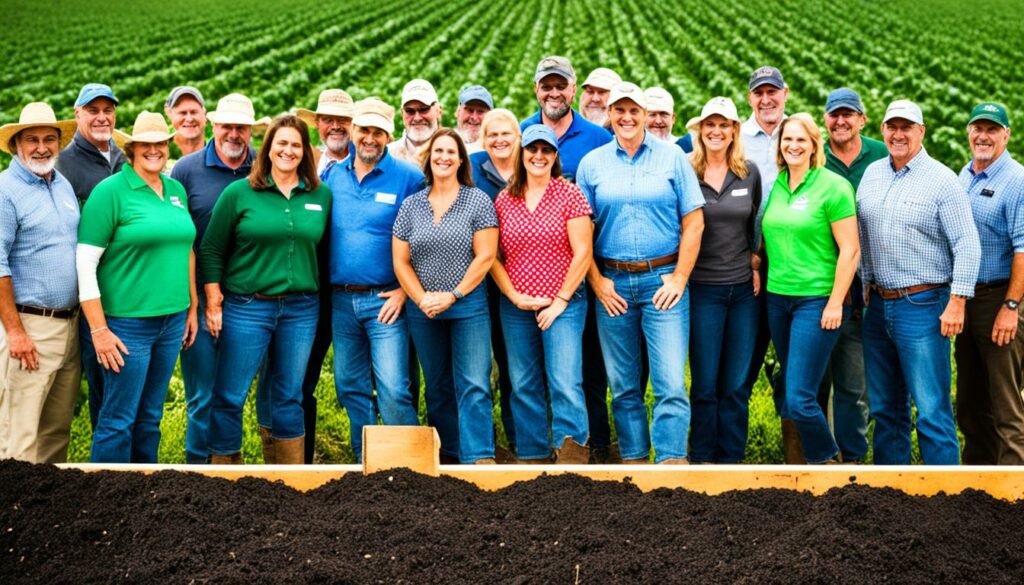
Grains, feeds, oilseeds, animals, meats, and horticultural products make up 90% of US agricultural exports. This shows where we could focus to grow more. Also, China, Mexico, and Canada are the top markets, making up 64% of the exports. So, giving these areas special attention could lead to big wins.
Analyzing import and export trends gives great insights for global markets. Though imports rose by 5.8%, US export share has stayed at 20% since 2008. This shows the world’s steady want for US farm goods.
Between 2017 and 2021, the US exported a lot to East Asia and North America, nearly 60% of all. This proves the need for strong trade relations in these places. The share of imported food and drinks also went up by 15% from 2011 to 2021. So, there’s more opportunity for US food items abroad.
“To capitalise on current trends, stakeholders must adopt comprehensive agri export strategies, harnessing the full potential of the US’s agricultural prowess while adapting to dynamic global market conditions.”
Knowing these market movements helps stakeholders create better export plans. Using new strategies and understanding the market well are the keys to global success. This is how we can make the most of our export chances.
Agricultural exports are vital for the U.S., boosting economic growth and trade worldwide. They made up 10% of the country’s total exports in 2012, reaching $141.3 billion. Nearly a million jobs are supported by this sector, with each billion in exports creating 6,800 American jobs.
Processed foods lead to higher economic gains and more jobs than raw goods. The U.S. often sees a trade surplus in agriculture. In the latest year, this surplus was $38.5 billion. Grains, soybeans, and animal products had big jumps in exports in 2012.
China became the top buyer of U.S. agricultural goods. This shows the value of strong international trade ties. Despite the pandemic, the agricultural trade remained strong. There are plans to make exports even better.
The U.S. will focus on trade deals, new tech, and eco-friendly farming. These steps are key for future success in exports. They will also help keep the U.S. as a top player in global agriculture.
The US is a leading exporter of many agricultural products. These include meats and dairy, fruits and veg, and processed foods. They’re popular worldwide for their quality and variety.
Agricultural exports are crucial for the American economy. They boost the GDP and create many jobs. They also support the economy in rural areas, keeping the trade balanced.
The key markets are in the European Union, Asia-Pacific, and North America. Also important are various emerging markets. Each region has different demands, offering unique chances for US sellers.
Tariffs and barriers can restrict US exports. High EU tariffs disadvantage American farmers. Overcoming these barriers through agreements and cooperation opens more export opportunities.
Agreements like TPP and T-TIP are essential. They lower tariffs and barriers. This makes the US more competitive globally and improves market access.
Sustainable practices and tech innovations increase output. They meet the demand for eco-friendly goods. This boosts export chances for the US.
Resilient food systems support ongoing exports and economic safety. By improving infrastructure and supply chains, the US adapts well to global changes. This maintains its export momentum.
Local and regional food systems strengthen both local and export growth. Investing in these areas supports economy diversification. It makes local markets more adaptable to global shifts.
Biobased items offer a sustainable alternative and new export chances. US programmes show a strong commitment to this. They aim to make a mark in this growing market.
The expanding middle class drives up the need for quality foods. The US is ready with various produce to meet this demand. This targets the market for premium products.
The middle supply chain is key for efficient export of goods. USDA investments ensure exports reach markets well. This makes American goods more competitive.
Investing in and supporting farmers boost innovation and efficiency. Government help provides access to markets, helping US farmers succeed globally.
By knowing market trends and planning strategically, stakeholders can succeed. This is key for exporting both traditional and new agricultural goods.